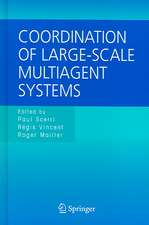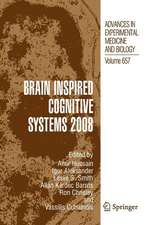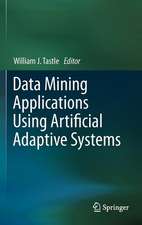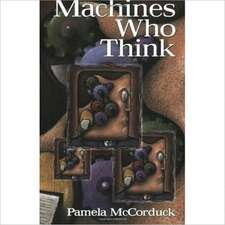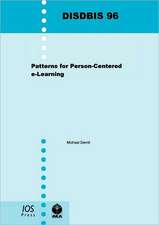Educational Data Mining: Applications and Trends: Studies in Computational Intelligence, cartea 524
Editat de Alejandro Peña-Ayalaen Limba Engleză Paperback – 23 aug 2016
· Profile: The first part embraces three chapters oriented to: 1) describe the nature of educational data mining (EDM); 2) describe how to pre-process raw data to facilitate data mining (DM); 3) explain how EDM supports government policies to enhance education.
· Student modeling: The second part contains five chapters concerned with: 4) explore the factors having an impact on the student's academic success; 5) detect student's personality and behaviors in an educational game; 6) predict students performance to adjust content and strategies; 7) identify students who will most benefit from tutor support; 8) hypothesize the student answer correctness based on eye metrics and mouse click.
· Assessment: The third part has four chapters related to: 9) analyze the coherence of student research proposals; 10) automatically generate tests based on competences; 11) recognize students activities and visualize these activities for being presented to teachers; 12) find the most dependent test items in students response data.
· Trends: The fourth part encompasses four chapters about how to: 13) mine text for assessing students productions and supporting teachers; 14) scan student comments by statistical and text mining techniques; 15) sketch a social network analysis (SNA) to discover student behavior profiles and depict models about their collaboration; 16) evaluate the structure of interactions between the students in social networks.
This volume will be a source of interest to researchers, practitioners, professors, and postgraduate students aimed at updating their knowledgeand find targets for future work in the field of educational data mining.
| Toate formatele și edițiile | Preț | Express |
|---|---|---|
| Paperback (1) | 894.24 lei 38-45 zile | |
| Springer International Publishing – 23 aug 2016 | 894.24 lei 38-45 zile | |
| Hardback (1) | 906.16 lei 38-45 zile | |
| Springer International Publishing – 20 noi 2013 | 906.16 lei 38-45 zile |
Din seria Studies in Computational Intelligence
- 50%
 Preț: 264.48 lei
Preț: 264.48 lei - 20%
 Preț: 1138.71 lei
Preț: 1138.71 lei - 20%
 Preț: 970.01 lei
Preț: 970.01 lei - 20%
 Preț: 1428.22 lei
Preț: 1428.22 lei - 20%
 Preț: 168.78 lei
Preț: 168.78 lei - 18%
 Preț: 1093.52 lei
Preț: 1093.52 lei - 20%
 Preț: 565.38 lei
Preț: 565.38 lei - 20%
 Preț: 638.34 lei
Preț: 638.34 lei - 20%
 Preț: 1030.03 lei
Preț: 1030.03 lei - 20%
 Preț: 1552.26 lei
Preț: 1552.26 lei - 20%
 Preț: 632.66 lei
Preț: 632.66 lei - 20%
 Preț: 646.41 lei
Preț: 646.41 lei - 20%
 Preț: 976.52 lei
Preț: 976.52 lei - 20%
 Preț: 974.09 lei
Preț: 974.09 lei - 20%
 Preț: 973.27 lei
Preț: 973.27 lei - 20%
 Preț: 1146.00 lei
Preț: 1146.00 lei - 20%
 Preț: 1420.10 lei
Preț: 1420.10 lei - 20%
 Preț: 1024.36 lei
Preț: 1024.36 lei - 20%
 Preț: 1030.03 lei
Preț: 1030.03 lei - 20%
 Preț: 1028.39 lei
Preț: 1028.39 lei - 18%
 Preț: 2458.20 lei
Preț: 2458.20 lei - 20%
 Preț: 972.45 lei
Preț: 972.45 lei - 20%
 Preț: 1146.00 lei
Preț: 1146.00 lei - 20%
 Preț: 1144.40 lei
Preț: 1144.40 lei - 20%
 Preț: 1025.17 lei
Preț: 1025.17 lei - 20%
 Preț: 1435.50 lei
Preț: 1435.50 lei - 18%
 Preț: 1379.82 lei
Preț: 1379.82 lei - 18%
 Preț: 1105.93 lei
Preț: 1105.93 lei - 20%
 Preț: 1021.92 lei
Preț: 1021.92 lei - 20%
 Preț: 991.11 lei
Preț: 991.11 lei - 20%
 Preț: 1027.60 lei
Preț: 1027.60 lei - 20%
 Preț: 1253.88 lei
Preț: 1253.88 lei - 20%
 Preț: 1022.74 lei
Preț: 1022.74 lei - 20%
 Preț: 971.65 lei
Preț: 971.65 lei - 20%
 Preț: 1150.03 lei
Preț: 1150.03 lei - 20%
 Preț: 1142.76 lei
Preț: 1142.76 lei - 20%
 Preț: 1041.37 lei
Preț: 1041.37 lei - 20%
 Preț: 1144.40 lei
Preț: 1144.40 lei - 20%
 Preț: 1146.83 lei
Preț: 1146.83 lei - 20%
 Preț: 1434.72 lei
Preț: 1434.72 lei - 18%
 Preț: 988.76 lei
Preț: 988.76 lei - 20%
 Preț: 980.55 lei
Preț: 980.55 lei - 20%
 Preț: 1038.11 lei
Preț: 1038.11 lei - 20%
 Preț: 1262.78 lei
Preț: 1262.78 lei - 20%
 Preț: 977.30 lei
Preț: 977.30 lei - 20%
 Preț: 1031.01 lei
Preț: 1031.01 lei - 20%
 Preț: 927.84 lei
Preț: 927.84 lei - 20%
 Preț: 1153.30 lei
Preț: 1153.30 lei - 20%
 Preț: 1433.08 lei
Preț: 1433.08 lei - 20%
 Preț: 1027.60 lei
Preț: 1027.60 lei
Preț: 894.24 lei
Preț vechi: 1117.80 lei
-20% Nou
Puncte Express: 1341
Preț estimativ în valută:
171.22€ • 178.29$ • 142.06£
171.22€ • 178.29$ • 142.06£
Carte tipărită la comandă
Livrare economică 10-17 februarie
Preluare comenzi: 021 569.72.76
Specificații
ISBN-13: 9783319344997
ISBN-10: 3319344994
Pagini: 486
Ilustrații: XVIII, 468 p. 139 illus.
Dimensiuni: 155 x 235 x 25 mm
Greutate: 0.68 kg
Ediția:Softcover reprint of the original 1st ed. 2014
Editura: Springer International Publishing
Colecția Springer
Seria Studies in Computational Intelligence
Locul publicării:Cham, Switzerland
ISBN-10: 3319344994
Pagini: 486
Ilustrații: XVIII, 468 p. 139 illus.
Dimensiuni: 155 x 235 x 25 mm
Greutate: 0.68 kg
Ediția:Softcover reprint of the original 1st ed. 2014
Editura: Springer International Publishing
Colecția Springer
Seria Studies in Computational Intelligence
Locul publicării:Cham, Switzerland
Cuprins
Part I: Profile
1 Which Contribution Does EDM Provide to Computer Based Learning Environments?
Nabila Bousbia, Idriss Belamri
2 A Survey on Pre-processing Educational Data
Cristóbal Romero, José Raúl Romero, Sebastián Ventura
3 How Educational Data Mining Empowers Government Policies to Re-form Education: The Mexican Case Study
Alejandro Peña-Ayala, Leonor Cárdenas
Part II: Student Modeling
4 Modeling Student Performance in Higher Education Using Data Mining
Huseyin Guruler, Ayhan Istanbullu
5 Using Data Mining Techniques to Detect the Personality of Players in an Educational Game
Fazel Keshtkar, Candice Burkett, Haiying Li, Arthur C. Graesser
6 Students’ Performance Prediction using Multi-Channel Decision Fusion
H. Moradi, S. Abbas Moradi, L. Kashani
7 Predicting Student Performance from Combined Data Sources
Annika Wolff, Zdenek Zdrahal, Drahomira Herrmannova, Petr Knoth
8 Predicting Learner Answers Correctness Through Eye Movements With Random Forest
Alper Bayazit, Petek Askar, Erdal Cosgun
Part III: Assessment
9 Mining Domain Knowledge for CoherenceAssessment of Students Proposal Drafts
Samuel González López, Aurelio López-López
10 Adaptive Testing in Programming Courses Based on Educational Data Mining Techniques
Vladimir Ivančević, Marko Knežević, Bojan Pušić, Ivan Luković
11 Plan Recognition and Visualization in Exploratory Learning Environments
Ofra Amir, Kobi Gal, David Yaron, Michael Karabinos, Robert Bel-ford
12 Dependency of Test Items from Students' Response Data
Xiaoxun Sun
Part IV : Trends
13 Mining Texts, Learner Productions and Strategies with ReaderBench
Mihai Dascalu, Philippe Dessus, Maryse Bianco, Stefan Trausan-Matu, Aurélie Nardy
14 Maximizing the Value of Student Ratings Through Data Mining
Kathryn Gates, Dawn Wilkins, Sumali Conlon, Susan Mossing, Mau-rice Eftink
15 Data Mining and Social Network Analysis in the Educational Field: An Application for Non-expert Users
Diego García-Saiz, Camilo Palazuelos, Marta Zorrilla
16 Collaborative Learning of Students in Online Discussion Forums: A Social Network Analysis Perspective
Reihaneh Rabbany, Samira ElAtia, Mansoureh Takaffoli, Osmar R. Zaïane
1 Which Contribution Does EDM Provide to Computer Based Learning Environments?
Nabila Bousbia, Idriss Belamri
2 A Survey on Pre-processing Educational Data
Cristóbal Romero, José Raúl Romero, Sebastián Ventura
3 How Educational Data Mining Empowers Government Policies to Re-form Education: The Mexican Case Study
Alejandro Peña-Ayala, Leonor Cárdenas
Part II: Student Modeling
4 Modeling Student Performance in Higher Education Using Data Mining
Huseyin Guruler, Ayhan Istanbullu
5 Using Data Mining Techniques to Detect the Personality of Players in an Educational Game
Fazel Keshtkar, Candice Burkett, Haiying Li, Arthur C. Graesser
6 Students’ Performance Prediction using Multi-Channel Decision Fusion
H. Moradi, S. Abbas Moradi, L. Kashani
7 Predicting Student Performance from Combined Data Sources
Annika Wolff, Zdenek Zdrahal, Drahomira Herrmannova, Petr Knoth
8 Predicting Learner Answers Correctness Through Eye Movements With Random Forest
Alper Bayazit, Petek Askar, Erdal Cosgun
Part III: Assessment
9 Mining Domain Knowledge for CoherenceAssessment of Students Proposal Drafts
Samuel González López, Aurelio López-López
10 Adaptive Testing in Programming Courses Based on Educational Data Mining Techniques
Vladimir Ivančević, Marko Knežević, Bojan Pušić, Ivan Luković
11 Plan Recognition and Visualization in Exploratory Learning Environments
Ofra Amir, Kobi Gal, David Yaron, Michael Karabinos, Robert Bel-ford
12 Dependency of Test Items from Students' Response Data
Xiaoxun Sun
Part IV : Trends
13 Mining Texts, Learner Productions and Strategies with ReaderBench
Mihai Dascalu, Philippe Dessus, Maryse Bianco, Stefan Trausan-Matu, Aurélie Nardy
14 Maximizing the Value of Student Ratings Through Data Mining
Kathryn Gates, Dawn Wilkins, Sumali Conlon, Susan Mossing, Mau-rice Eftink
15 Data Mining and Social Network Analysis in the Educational Field: An Application for Non-expert Users
Diego García-Saiz, Camilo Palazuelos, Marta Zorrilla
16 Collaborative Learning of Students in Online Discussion Forums: A Social Network Analysis Perspective
Reihaneh Rabbany, Samira ElAtia, Mansoureh Takaffoli, Osmar R. Zaïane
Recenzii
From the book reviews:
“This book delivers on its promise to bring together the essence of educational data mining, both in terms of principle and practice. It deserves a place on the reading shelf of any researcher interested in advancing educational goals using advanced techniques and methodologies.” (Computing Reviews, July, 2014)
“This book delivers on its promise to bring together the essence of educational data mining, both in terms of principle and practice. It deserves a place on the reading shelf of any researcher interested in advancing educational goals using advanced techniques and methodologies.” (Computing Reviews, July, 2014)
Textul de pe ultima copertă
This book is devoted to the Educational Data Mining arena. It highlights works that show relevant proposals, developments, and achievements that shape trends and inspire future research. After a rigorous revision process sixteen manuscripts were accepted and organized into four parts as follows:
· Profile: The first part embraces three chapters oriented to: 1) describe the nature of educational data mining (EDM); 2) describe how to pre-process raw data to facilitate data mining (DM); 3) explain how EDM supports government policies to enhance education.
· Student modeling: The second part contains five chapters concerned with: 4) explore the factors having an impact on the students academic success; 5) detect student's personality and behaviors in an educational game; 6) predict students performance to adjust content and strategies; 7) identify students who will most benefit from tutor support; 8) hypothesize the student answer correctness based on eye metrics and mouse click.
· Assessment: The third part has four chapters related to: 9) analyze the coherence of student research proposals; 10) automatically generate tests based on competences; 11) recognize students activities and visualize these activities for being presented toteachers; 12) find the most dependent test items in students response data.
· Trends: The fourth part encompasses four chapters about how to: 13) mine text for assessing students productions and supporting teachers; 14) scan student comments by statistical and text mining techniques; 15) sketch a social network analysis (SNA) to discover student behavior profiles and depict models about their collaboration; 16) evaluate the structure of interactions between the students in social networks.
This volume will be a source of interest to researchers, practitioners, professors, and postgraduate students aimed at updating their knowledge and find targets for future work in the field of educational data mining.
· Profile: The first part embraces three chapters oriented to: 1) describe the nature of educational data mining (EDM); 2) describe how to pre-process raw data to facilitate data mining (DM); 3) explain how EDM supports government policies to enhance education.
· Student modeling: The second part contains five chapters concerned with: 4) explore the factors having an impact on the students academic success; 5) detect student's personality and behaviors in an educational game; 6) predict students performance to adjust content and strategies; 7) identify students who will most benefit from tutor support; 8) hypothesize the student answer correctness based on eye metrics and mouse click.
· Assessment: The third part has four chapters related to: 9) analyze the coherence of student research proposals; 10) automatically generate tests based on competences; 11) recognize students activities and visualize these activities for being presented toteachers; 12) find the most dependent test items in students response data.
· Trends: The fourth part encompasses four chapters about how to: 13) mine text for assessing students productions and supporting teachers; 14) scan student comments by statistical and text mining techniques; 15) sketch a social network analysis (SNA) to discover student behavior profiles and depict models about their collaboration; 16) evaluate the structure of interactions between the students in social networks.
This volume will be a source of interest to researchers, practitioners, professors, and postgraduate students aimed at updating their knowledge and find targets for future work in the field of educational data mining.
Caracteristici
Provides an updated view of the application of Data Mining to the educational arena Copes two key targets: applications and trends Focuses on the Data Mining logistics: models, tasks, methods, algorithms

